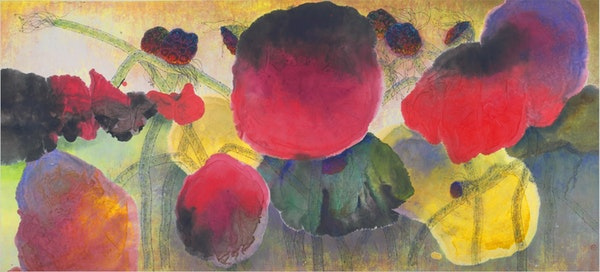log in
Enter site
Login to use Arthive functionality to the maximum
Expressive ink: paintings by Yang Yanping and Zeng Shanqing
Exhibition August 10 − November 10, 2019
Yang Yanping and her husband Zeng Shangqing belong to a generation of Chinese artists whose early career was suppressed by the cultural revolution of Mao Zedong. From 1949 to the end of the 1970s, the People’s Republic of China regulated the life and work of its artists, restricting their expression and eliminating international influence. Because this policy was weakened, Yang and Zeng were able to freely practice their art in China, gaining recognition before moving to the United States in 1986.
Yang developed a unique style in the early 1980s, executed in traditional Chinese painting, but undoubtedly modern. Originally an architect, she worked in oils, and then switched to more traditional Chinese media — ink on paper. Her signature style includes a wavy ink line with tiny dots made with a pen, rather than a brush, depicting her favorite themes: lotuses and landscapes. Contrasting colors of Yang, often red-hot in shades, flow into each other, dissolving these objects into abstract color nebulae.
Zeng's work was mainly focused on drawing figures and horses, more acceptable objects in early revolutionary China. Nevertheless, the former professor of the Central Academy of Arts was subjected to political criticism during the cultural revolution and survived several years of physical labor. Boldly, Zeng's polychrome figures, drawn by a large, rapidly developing brush, are an expression of dynamic and restrained energy. Their distorted forms, sometimes in the position of the fetus, hint at the trauma of his early years.
Yang developed a unique style in the early 1980s, executed in traditional Chinese painting, but undoubtedly modern. Originally an architect, she worked in oils, and then switched to more traditional Chinese media — ink on paper. Her signature style includes a wavy ink line with tiny dots made with a pen, rather than a brush, depicting her favorite themes: lotuses and landscapes. Contrasting colors of Yang, often red-hot in shades, flow into each other, dissolving these objects into abstract color nebulae.
Zeng's work was mainly focused on drawing figures and horses, more acceptable objects in early revolutionary China. Nevertheless, the former professor of the Central Academy of Arts was subjected to political criticism during the cultural revolution and survived several years of physical labor. Boldly, Zeng's polychrome figures, drawn by a large, rapidly developing brush, are an expression of dynamic and restrained energy. Their distorted forms, sometimes in the position of the fetus, hint at the trauma of his early years.




